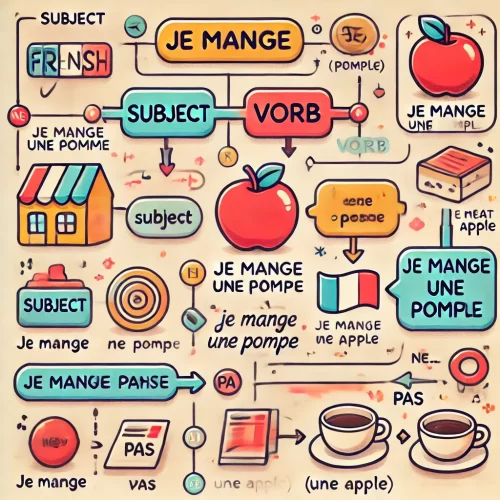Learning how to form simple sentences is one of the first and most important steps in mastering the French language. Whether you’re a complete beginner or looking to improve your basic French, forming simple sentences is a foundational skill that will allow you to communicate effectively. In this article, we’ll walk you through the essential building blocks of French sentence structure, including common sentence patterns, grammar rules, and tips for forming sentences with confidence.
1. Basic French Sentence Structure
French follows a Subject-Verb-Object (SVO) word order, similar to English. This means that a basic sentence typically consists of:
- Subject (who is doing the action)
- Verb (the action being performed)
- Object (the recipient of the action, if any)
Let’s look at an example:
- English: I eat an apple.
- French: Je mange une pomme.
In this sentence:
- Subject: “Je” (I)
- Verb: “mange” (eat)
- Object: “une pomme” (an apple)
Notice that the structure is identical to English, making it easy to grasp for beginners.
2. Common French Pronouns (Subjects)
Before diving deeper into sentence formation, it’s important to know the French subject pronouns. These are the words you’ll use to identify who is doing the action in a sentence:
- Je = I
- Tu = You (informal)
- Il/Elle/On = He/She/One (or “we” in casual speech)
- Nous = We
- Vous = You (formal or plural)
- Ils/Elles = They (masculine/feminine)
3. Conjugating Verbs in French
One of the key differences between French and English is verb conjugation. In French, the form of the verb changes depending on the subject pronoun and tense.
Let’s take the verb “manger” (to eat) as an example:
- Je mange = I eat
- Tu manges = You eat
- Il/Elle mange = He/She eats
- Nous mangeons = We eat
- Vous mangez = You eat (formal/plural)
- Ils/Elles mangent = They eat
Each subject pronoun requires a different verb form. While this might seem daunting at first, it becomes easier with practice.
4. Forming Affirmative Sentences
An affirmative sentence is simply a statement. To form an affirmative sentence in French, follow the basic Subject-Verb-Object (SVO) structure.
Example 1:
- English: She likes coffee.
- French: Elle aime le café.
In this example:
- Subject: “Elle” (She)
- Verb: “aime” (likes)
- Object: “le café” (coffee)
Example 2:
- English: We speak French.
- French: Nous parlons français.
In this example:
- Subject: “Nous” (We)
- Verb: “parlons” (speak)
- Object: “français” (French)
5. Forming Negative Sentences
In French, negative sentences are formed by placing “ne” before the verb and “pas” after the verb.
Example 1:
- English: I do not understand.
- French: Je ne comprends pas.
In this example:
- “ne” goes before “comprends” (understand), and “pas” comes after the verb to make the sentence negative.
Example 2:
- English: They are not eating.
- French: Ils ne mangent pas.
6. Asking Questions in French
There are several ways to ask questions in French. The most common methods include using intonation, “est-ce que”, and inversion.
Method 1: Intonation
In informal conversation, you can simply raise your voice at the end of a sentence to turn it into a question.
- Statement: Tu parles français. (You speak French.)
- Question: Tu parles français? (Do you speak French?)
Method 2: “Est-ce que”
Adding “est-ce que” at the beginning of a sentence makes it a formal question.
- Statement: Vous aimez le chocolat. (You like chocolate.)
- Question: Est-ce que vous aimez le chocolat? (Do you like chocolate?)
Method 3: Inversion
In formal writing or speech, you can invert the subject and verb to ask a question.
- Statement: Elle mange une pomme. (She is eating an apple.)
- Question: Mange-t-elle une pomme? (Is she eating an apple?)
7. Using Adjectives in Simple Sentences
In French, adjectives usually follow the noun they describe, unlike in English where they precede the noun. Additionally, adjectives must agree in gender and number with the noun.
Example 1:
- English: The red car.
- French: La voiture rouge.
Example 2:
- English: The small dogs.
- French: Les petits chiens.
Notice that “petits” (small) changes to match the plural noun “chiens” (dogs).
8. Common Sentence Starters
Here are a few useful phrases to start simple sentences in French:
- Je veux = I want
- J’ai besoin de = I need
- Il y a = There is/are
- Je pense que = I think that
- Je suis = I am
9. Practice: Putting It All Together
Now that we’ve covered the basics, let’s try forming a few simple sentences using these rules:
- I want a coffee. = Je veux un café.
- He is not tired. = Il n’est pas fatigué.
- There is a book on the table. = Il y a un livre sur la table.
- Do you like pizza? = Est-ce que tu aimes la pizza?
Conclusion
Forming simple sentences in French is an essential skill that serves as the foundation for more complex communication. By mastering subject pronouns, verb conjugations, sentence structure, and basic question forms, you’ll be well on your way to speaking and writing confidently in French. Regular practice and repetition are key, so don’t be afraid to experiment with different sentence patterns. Happy learning!


